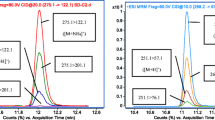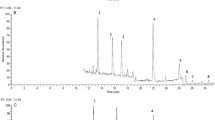Abstract
A reliable and affordable QuEChERS (quick, easy, cheap, effective, rugged, and safe) methodology in combination with ultra-high performance liquid chromatography-tandem mass spectrometry (UPLC–MS/MS) was successfully developed and validated for the determination of eight bisphenols (BPs) residues containing in meats (chicken, duck, beef, pork, fish, shrimp, and mutton). A novel QuEChERS method optimization was carried out in terms of process efficiency (PE), matrix effect (ME), and extraction recovery (RE). After a simple vortex extraction of the samples with acetonitrile, 1 g sodium acetate was used for salting out (NaAC), and 100 mg primary secondary amine (PSA) purifying reagents were used for purification. The properties of the sorbents were assessed by the obtained parameters, such as matrix effect (ME), linearity, sensitivity, accuracy, and precision. Under the optimal conditions, BPs were well separated on an ACQUITY UPLC BEH ® C18 column in 8 min by gradient elution, and exhibited a good linear relationship (R2 > 0.9988) in the linear range. Moreover, the limits of detection (LODs) and the limits of quantification (LOQs) were located in the range of 0.01– 0.11 μg/kg and 0.03 – 0.37 μg/kg, respectively. The developed method was satisfactory in terms of accuracy (relative recoveries: 76.1% – 113.7%) and precision (relative standard deviations below 10.3%). Finally, the developed method was successfully employed to identify and quantify BPs residues in 28 real meat samples. The proposed QuEChERS-UPLC–MS/MS method is simple, high efficiency, cost-effective, practical, and susceptible to being implemented in routine laboratories to quickly detect the BPs in meats (chicken, duck, beef, pork, fish, shrimp, and mutton). In this sense, the method is useful for obtaining BPs residue data to evaluate the contamination status of BPs in meat food and provide scientific support for scientific supervision.







Similar content being viewed by others
References
Diamanti-Kandarakis E, Bourguignon J-P, Giudice LC, Hauser R, Prins GS, Soto AM, Zoeller RT, Gore AC (2009) Endocrine-disrupting chemicals: an Endocrine Society scientific statement. Endocr Rev 30(4):293–342
Le Magueresse-Battistoni B, Labaronne E, Vidal H, Naville D (2017) Endocrine disrupting chemicals in mixture and obesity, diabetes and related metabolic disorders. World J Biol Chem 8(2):108
Russo G, Capuozzo A, Barbato F, Irace C, Santamaria R, Grumetto L (2018) Cytotoxicity of seven bisphenol analogues compared to bisphenol A and relationships with membrane affinity data. Chemosphere 201:432–440
Usman A, Ahmad M (2016) From BPA to its analogues: is it a safe journey? Chemosphere 158:131–142
Geens T, Aerts D, Berthot C, Bourguignon J-P, Goeyens L, Lecomte P, Maghuin-Rogister G, Pironnet A-M, Pussemier L, Scippo M-L (2012) A review of dietary and non-dietary exposure to bisphenol-A. Food Chem Toxicol 50(10):3725–3740
Geens T, Goeyens L, Covaci A (2011) Are potential sources for human exposure to bisphenol-A overlooked? Int J Hyg Envir Heal 214(5):339–347
Liao CY, Kannan K (2011) Widespread occurrence of bisphenol A in paper and paper products: implications for human exposure. Environ Sci Technol 45(21):9372–9379
Alonso-Magdalena P, Ropero AB, Soriano S, García-Arévalo M, Ripoll C, Fuentes E, Quesada I, Nadal Á (2012) Bisphenol-A acts as a potent estrogen via non-classical estrogen triggered pathways. Mol Cell Endocrinol 355(2):201–207
Hwang K-A, Park M-A, Kang N-H, Yi B-R, Hyun S-H, Jeung E-B, Choi K-C (2013) Anticancer effect of genistein on BG-1 ovarian cancer growth induced by 17 β-estradiol or bisphenol A via the suppression of the crosstalk between estrogen receptor alpha and insulin-like growth factor-1 receptor signaling pathways. Toxicol Appl Pharm 272(3):637–646
Acevedo N, Davis B, Schaeberle CM, Sonnenschein C, Soto AM (2013) Perinatally administered bisphenol a as a potential mammary gland carcinogen in rats. Environ Health Persp 121(9):1040–1046
Park M-A, Choi K-C (2013) Effects of 4-nonylphenol and bisphenol A on stimulation of cell growth via disruption of the transforming growth factor-β signaling pathway in ovarian cancer models. Chem Res Toxicol 27(1):119–128
Bahelka I, Stupka R, Ítek J, Prysl M (2021) The impact of bisphenols on reproductive system and on offspring in pigs – A review 2011–2020. Chemosphere 263(3):128203
Skledar DG, Mašič LP (2016) Bisphenol A and its analogs: do their metabolites have endocrine activity? Environ Toxicol Pharm 47:182–199
Cy L, Kannan K (2013) Concentrations and profiles of bisphenol A and other bisphenol analogues in foodstuffs from the United States and their implications for human exposure. J Agr Food Chem 61(19):4655–4662
Žalmanová T, Hošková K, Nevoral J, Prokešová Š, Zámostná K, Kott T, Petr J (2016) Bisphenol S instead of bisphenol A: a story of reproductive disruption by regretable substitution-a review. Czech J Anim Sci 61(10):433–449
Wang L, Xue J, Kannan K (2015) Widespread occurrence and accumulation of bisphenol A diglycidyl ether (BADGE), bisphenol F diglycidyl ether (BFDGE) and their derivatives in human blood and adipose fat. Environ Sci Technol 49(5):3150–3157
Eladak S, Grisin T, Moison D, Guerquin M-J, N’Tumba-Byn T, Pozzi-Gaudin S, Benachi A, Livera G, Rouiller-Fabre V, Habert R (2015) A new chapter in the bisphenol A story: bisphenol S and bisphenol F are not safe alternatives to this compound. Fertil Steril 103(1):11–21
Sosvorova LK, Chlupacova T, Vitku J, Vlk M, Heracek J, Starka L, Saman D, Simkova M, Hampl R (2017) Determination of selected bisphenols, parabens and estrogens in human plasma using LC-MS/MS. Talanta 174:21–28
Rochester JR, Bolden AL (2015) Bisphenol S and F: a systematic review and comparison of the hormonal activity of bisphenol A substitutes. Environ Health Persp 123(7):643–650
Gyimah E, Xu H, Dong X, Xc Qiu, Zhang Z, Yq Bu, Akoto O (2021) Developmental neurotoxicity of low concentrations of bisphenol A and S exposure in zebrafish. Chemosphere 262:128045
Pavel Š, Helena Š, Kateřina G, Farah GA, Tomáš M, Vít K, Diana BL, Bruås HL, Roman G, Hana KK (2021) Bisphenols emerging in Norwegian and Czech aquatic environments show transthyretin binding potency and other less-studied endocrine-disrupting activities. Science of the Total Environment 751:141801
Braver-Sewradj SPD, Spronsen RV, Hessel EVS (2020) Substitution of bisphenol A: a review of the carcinogenicity, reproductive toxicity, and endocrine disruption potential of alternative substances. Crit Rev Toxicol 50(2):128–147
Liu J, Zhang L, Lu G, Jiang R, Yan Z, Li Y (2021) Occurrence, toxicity and ecological risk of Bisphenol A analogues in aquatic environment – A review. Ecotox Environ Safe 208:111481–111481
Ygndodu R, Stnda A, Duydu Y (2020) Toxicological Evaluation of Bisphenol A and Its Analogues. Turkish J Pharmaceut Sci 17(4):457–462
Khim J, Lee K, Kannan K, Villeneuve D, Giesy J, Koh C (2001) Trace organic contaminants in sediment and water from Ulsan Bay and its vicinity. Korea Arch Environ Con Tox 40(2):141–150
Drewes JE, Hemming J, Ladenburger SJ, Schauer J, Sonzogni W (2005) An assessment of endocrine disrupting activity changes during wastewater treatment through the use of bioassays and chemical measurements. Water Environ Res 77(1):12–23
Liao C, Kannan K (2013) Concentrations and profiles of bisphenol A and other bisphenol analogues in foodstuffs from the United States and their implications for human exposure. J Agr Food Chem 61(19):4655–4662
Liao CY, Liu F, Guo Y, Moon H-B, Nakata H, Wu Q, Kannan K (2012) Occurrence of eight bisphenol analogues in indoor dust from the United States and several Asian countries: implications for human exposure. Environ Sci Technol 46(16):9138–9145
Hy B, Zy Li, Liu P, Jf P (2010) Spatial distribution and deposition history of nonylphenol and bisphenol A in sediments from the Changjiang River(Yangtze River) Estuary and its adjacent East China Sea. Acta Oceanol Sin 29(05):44–51
Cao X-L, Perez-Locas C, Dufresne G, Clement G, Popovic S, Beraldin F, Dabeka R, Feeley M (2011) Concentrations of bisphenol A in the composite food samples from the 2008 Canadian total diet study in Quebec City and dietary intake estimates. Food Addit Contam 28(6):791–798
Barbieri MV, Postigo C, Guillem-Argiles N, Monllor-Alcaraz LS, Simionato JI, Stella E, Barcelo D, Lopez de Alda M (2019) Analysis of 52 pesticides in fresh fish muscle by QuEChERS extraction followed by LC-MS/MS determination. Sci Total Environ 653:958–967
Yin Y, Zhao C, Zheng G, Li L, Liu S, Shan Q, Ma L, Zhu X (2018) Development of styrene-divinylbenzene copolymer beads using QuEChERS for simultaneous detection and quantification of 13 perfluorinated compounds in aquatic samples. Microchem J 144:166–171
Matuszewski BK, Constanzer ML, Chavez-Eng CM (2003) Strategies for the assessment of matrix effect in quantitative bioanalytical methods based on HPLC-MS/MS. Anal Chem 75(13):3019–3030
Li GR, Yu WQ, Xiao ZJ, Long M, Tong LY, Qiu Y (2020) A modified QuEChERS/GC–MS for simultaneous determination of 16 pesticide adjuvant residues in fruits and vegetables. SN Appl. Sci. 2(1):35
Lehotay SJ, Mastovska K, Lightfield AR, Gates RA (2010) Multi-analyst, multi-matrix performance of the QuEChERS approach for pesticide residues in foods and feeds using HPLC/MS/MS analysis with different calibration techniques. J AOAC Int 93(2):355–367
Hernández-Mesa M, García-Campaña AM, Cruces-Blanco C (2018) Development and validation of a QuEChERS method for the analysis of 5-nitroimidazole traces in infant milk-based samples by ultra-high performance liquid chromatography-tandem mass spectrometry. J Chromatogr A 1562:36–46
Anastassiades M, Lehotay SJ, Štajnbaher D, Schenck FJ (2003) Fast and easy multiresidue method employing acetonitrile extraction/partitioning and “dispersive solid-phase extraction” for the determination of pesticide residues in produce. J AOAC Int 86(2):412–431
Ferrer C, Lozano A, Agüera A, Girón A, Fernández-Alba A (2011) Overcoming matrix effects using the dilution approach in multiresidue methods for fruits and vegetables. J Chromatogr A 1218(42):7634–7639
Xiong W, Jing H, Guo D, Wang Y, Yang F (2021) A novel method for the determination of fungicide residues in tobacco by ultra-performance liquid chromatography-tandem mass spectrometry combined with pass-through solid-phase extraction. Chromatographia 84(8):729–740
Gao J, Ma C, Duan Q, Gao W, Li H (2021) Simultaneous determination of 16 illegally added drugs in capsule dietary supplements using a QuEChERS method and HPLC–MS/MS. Chromatographia 84:1009–1023
Cunha SC, Cunha C, Ferreira AR, Fernandes JO (2012) Determination of bisphenol A and bisphenol B in canned seafood combining QuEChERS extraction with dispersive liquid-liquid microextraction followed by gas chromatography-mass spectrometry. Anal Bioanal Chem 404(8):2453–2463
Cunha SC, Inácio T, Almada M, Ferreira R, Fernandes JO (2020) Gas chromatography-mass spectrometry analysis of nine bisphenols in canned meat products and human risk estimation. Food Res Int 135:109293
Adeyi AA, Babalola BA (2019) Bisphenol-A (BPA) in foods commonly consumed in southwest nigeria and its human health risk. Sci Rep 9(1):17458
Yao K, Wen K, Shan W, Xie S, Peng T, Wang J, Jiang H, Shao B (2018) Development of an immunoaffinity column for the highly sensitive analysis of bisphenol A in 14 kinds of foodstuffs using ultra-high-performance liquid chromatography tandem mass spectrometry. J Chromatogr, B: Anal Technol Biomed Life Sci 1080:50
Yao K, Zhang J, Yin J, Zhao Y, Shao B (2020) Bisphenol A and its analogues in chinese total diets: contaminated levels and risk assessment. Oxid Med Cell Longev 1:1–14
Cao XL, Kosarac I, Popovic S, Zhou S, Smith D, Dabeka R (2019) LC-MS/MS analysis of bisphenol S and five other bisphenols in total diet food samples. Food Addit Contam 36(11):1740–1747
Acknowledgements
The work was supported by Science and Technology Planning Project of Guangyuan City (No. 19ZDYF0016).
Author information
Authors and Affiliations
Corresponding author
Ethics declarations
Conflict of interest
The authors declare that there is no conflict of competing financial interests.
Additional information
Publisher's Note
Springer Nature remains neutral with regard to jurisdictional claims in published maps and institutional affiliations.
Rights and permissions
About this article
Cite this article
Tan, X., Jin, Q., Lu, J. et al. Development and Validation of a Modified QuEChERS Method for the Analysis of Bisphenols in Meats by UPLC-MS/MS. Chromatographia 85, 433–445 (2022). https://doi.org/10.1007/s10337-022-04149-9
Received:
Revised:
Accepted:
Published:
Issue Date:
DOI: https://doi.org/10.1007/s10337-022-04149-9




